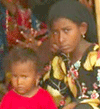NORTH YEMEN (IPS/Al Jazeera) — In the searing heat of the desert near the Saudi border, the sound of heavy artillery echoes across the mountains every few minutes, hammering the ears of Askar Ragass and her terrified family.

|
|
Askar says she and her family fled the fighting and sought refuge at the al-Mazraq IDP camp. PHOTO: AlJazeera. |
“We’re so scared,” Askar, a farmer, tells Al Jazeera from her tent in al-Mazraq camp, where she and 500 other displaced families have been living after fleeing their villages.
“Whenever we hear a sound, we run into our tents. We remember what happened back home. The sound of bombing never leaves your mind. When you hear a plane, you just freeze and can’t move — you think it’s about to fire on you.”
It is understandable why families here would feel unsafe. On Sep. 16, over 80 people were killed during an air raid on a settlement for displaced civilians in Amran province a few hundred kilometers away.
In August, the army launched the “Operation Scorched Earth” offensive against Shi’a rebels fighting for greater autonomy in Yemen’s northernmost Saada province.
The ensuing conflict turned out to be one that impoverished Yemen could ill afford, and it has hit the people of this agricultural region hard.
Nearly 10 percent of the children arriving at the al-Mazraq camp are severely malnourished and have to be sent to a local hospital for immediate therapeutic feeding to prevent permanent damage to their frail bodies and young minds.

|
|
UN agencies say they have been unable to provide assistance to many of the displaced. PHOTO: AlJazeera. |
Of the estimated 150,000 displaced civilians in northern Yemen, they are the only ones with immediate access to clean drinking water, food, medical attention and, most importantly, security. Tens of thousands more who fled their homes are now trapped by the fighting, living under bridges and trees with little or no access to aid.
The Yemeni aid group al-Amal is one of the only organizations with workers on the ground inside the war zone.
“We are on the verge of a major human catastrophe,” says Tayyib Izzedeen, the deputy director of al-Amal.
“Inside Saada City there is nothing to eat, there is no electricity, no water, no medicine, and if you can find anything, its price has tripled.”
Izzedeen says the situation is even more critical in Baqim, 20 km from the Saudi border, where up to 30,000 civilians, the vast majority of them women and children, are stranded in the open without food or water and caught in the crossfire.
“They are surrounded by fighting between tribes and the Houthis, and by bombing from government fighter jets,” says Izzedeen.
“They have nothing to eat, no medicine, no security, no shelter — anything one needs to survive, they don’t have.”
U.N. agencies blocked on the Yemeni-Saudi border have been unable to provide assistance and have watched the suffering of innocent civilians just a few kilometers away.
“There are no humanitarian corridors whatsoever,” says Laure Chedrawi of the U.N. High Commission on Refugees.
“In fact, humanitarian access is tightening by the day. We continue to call on the Yemeni and Saudi governments to allow us to aid the people of Baqim camp.”
The Yemeni army blocks aid access to civilians inside the war zone with checkpoints, saying conditions are too unsafe for civilians to move out or aid workers to move in.
The Saudi government prevents any cross-border movement of aid workers or families, fearing Houthi rebels could masquerade as refugees to enter the kingdom.
Meanwhile, the lack of organized, clearly demarcated civilian camps inside the war zone is adding to the confusion and haze of war — with tragic consequences.
“The large number of people recently killed in Amran province sends a very disturbing message to the displaced civilians,” says Naseem Ur-Rehman of the United Nations Children’s Fund. “The government says there were no internally displaced people [IDPs] there, but the reality is the IDPs are spread over vast stretches of land. Now they are confused about where they should go.”
Hassan Ahmed Naba’ee and his family were among the few able to find a way out of the war zone and to reach al-Mazraq camp.
“A mortar and artillery attack started on us at night,” Naba’ee tells al Jazeera, beads of sweat running down his face in the suffocating heat of the family tent. “There was an attack on state targets — then the government struck back. They bombed randomly on our villages and homes. We couldn’t possibly stay — we just left our houses and fled.”
Naba’ee’s newborn twins, Abdullah and Noura, wail inconsolably as family members take turns fanning them with bits of cardboard. No one knows how long they will be in this camp.
The war, which has raged intermittently since 2004, seems unending and is now spreading.
Now far beyond the borders of northern Saada province, it has enveloped parts of neighboring Amran, Jowf and Hajja provinces, threatening to destabilize the country and cause famine in the north.
And if the situation at al-Mazraq camp indicates conditions for northern civilians at their best, then there is much to worry about.
“Al-Mazraq is secure,” warns Izzedeen of al-Amal. “That is why you see aid organizations working there providing assistance. “But in all other areas of northern Yemen, we face an impending humanitarian disaster.”






Leave a Reply